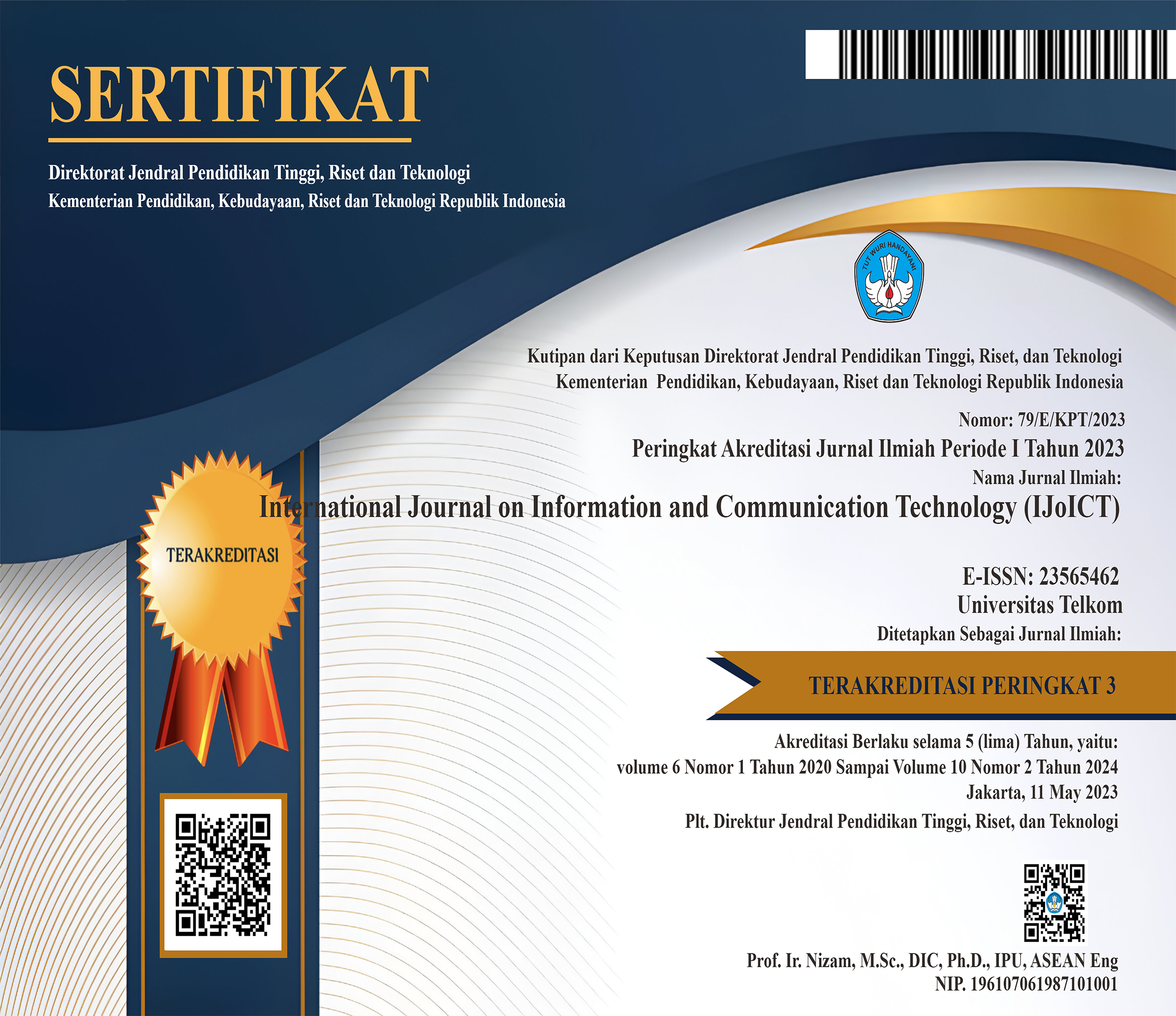Hoax Detection of Covid-19 News on Social Media using Convolutional Neural Network (CNN) and Support Vector Machine (SVM)
 Abstract views: 68
,
Abstract views: 68
,
 pdf downloads: 49
pdf downloads: 49
Abstract
It is undeniable that nowadays news spreads very quickly on social media. The ease of getting news on social media has resulted in some users using and spreading news without knowing the authenticity of the news. Twitter (X) users play an important role in spreading news on social media. In early 2020, cases of Covid-19 started to occur in Indonesia and some people spread news about Covid-19 without knowing the real information. The news is increasingly spreading through Twitter media which is shared by irresponsible people. This research builds a system that can detect hoax news on social media. The stages in this study started from crawling data, data preprocessing, word embedding, data separation, modeling process, and model evaluation. The methods used are Convolutional Neural Network (CNN) and Support Vector Machine (SVM). The dataset used is news of Covid-19 in X Social media. The experiment showt that the use of the N-Gram Unigram + Bigram + Trigram combination on CNN produces an accuracy value of 75.8%, meanwhile in the SVM modeling produces 77.9%. It can be concluded that SVM has better performance than CNN in detecting hoax news,
Downloads
References
[2] S. Khaled, N. El-Tazi, and H. M. O. Mokhtar, “Detecting Fake Accounts on Social Media,” Proc. - 2018 IEEE Int. Conf. Big Data, Big Data 2018, no. 05, pp. 3672–3681, 2019, doi: 10.1109/BigData.2018.8621913.
[3] A. Giachanou, B. Ghanem, E. A. Ríssola, P. Rosso, F. Crestani, and D. Oberski, The impact of psycholinguistic patterns in discriminating between fake news spreaders and fact checkers. Springer International Publishing, 2022.
[4] I. K. Sastrawan, I. P. A. Bayupati, and D. M. S. Arsa, “Detection of fake news using deep learning CNN–RNN based methods,” ICT Express, vol. 8, no. 3, pp. 396–408, 2022, doi: 10.1016/j.icte.2021.10.003.
[5] B. Rath, A. Salecha, and J. Srivastava, “Detecting Fake News Spreaders in Social Networks using Inductive Representation Learning,” Proc. 2020 IEEE/ACM Int. Conf. Adv. Soc. Networks Anal. Mining, ASONAM 2020, pp. 182–189, 2020, doi: 10.1109/ASONAM49781.2020.9381466.
[6] S. Yuliani, S. Sahib, M. F. Bin Abdollah, and F. Z. Ruskanda, “Hoax News Classification using Machine Learning Algorithms,” Int. J. Eng. Adv. Technol., 2019, doi: 10.35940/ijeat.b3753.129219.
[7] T. Widaretna, J. Tirtawangsa, and A. Romadhony, “Indonesian Hoax Identification on Tweets Using Doc2Vec,” e-Proceeding Eng. Vol.8 No.2, 2021.
[8] Indriani, “Kementerian Komunikasi dan Informatika,” https://www.kominfo.go.id/, 2020. .
[9] A. A. Kurniawan and M. Mustikasari, “Implementasi Deep Learning Menggunakan Metode CNN dan LSTM untuk Menentukan Berita Palsu dalam Bahasa Indonesia,” J. Inform. Univ. Pamulang, vol. 5, no. 4, p. 544, 2021, doi: 10.32493/informatika.v5i4.6760.
[10] A. Jamaludin and E. Setiawan, “Deteksi Berita Hoax di Media Sosial Twitter dengan Ekspansi Fitur Menggunakan Glove,” e-Proceeding Eng., vol. 9, no. 3, pp. 1847–1854, 2022.
[11] O. Ajao, D. Bhowmik, and S. Zargari, “fake CNN-RNN 2018.pdf,” pp. 226–230, 2018.
[12] W. Pamungkas and S. Suryani, “Deteksi Hoax Untuk Berita Hoax Covid 19 Indonesia Menggunakan CNN,” vol. 8, no. 5, pp. 10264–10276, 2021.
[13] I. M. Mubaroq and E. B. Setiawan, “The Effect of Information Gain Feature Selection for Hoax Identification in Twitter Using Classification Method Support Vector Machine,” Indones. J. …, vol. 5, no. September, pp. 107–118, 2020, doi: 10.21108/indojc.2020.5.2.499.
[14] Garg;Sonal and D. K. Sharma, “Fake News Classification via CNN,” 2022.
[15] K. Shu, A. Sliva, S. Wang, J. Tang, and H. Liu, “Fake News Detection on Social Media: A Data Mining Perspective,” no. i, 2019.
[16] M. K. Balwant, “Bidirectional LSTM Based on POS tags and CNN Architecture for Fake News Detection,” 2019 10th Int. Conf. Comput. Commun. Netw. Technol. ICCCNT 2019, no. December, 2019, doi: 10.1109/ICCCNT45670.2019.8944460.
[17] G. B. Hendra Rio, “Sosialisasi Dampak dan Bahaya Dari Berita Bohong (Hoax) Bagi Generasi Milenial di Indonesia,” J. Abdi Masy. Progr. Stud. Tek. Inform. Univ. Pamulang, vol. 1, pp. 20–35, 2020.
[18] F. R. Tama and Y. Sibaroni, “Fake News (Hoaxes) Detection on Twitter Social Media Content through Convolutional Neural Network (CNN) Method,” JINAV J. Inf. …, vol. 1, no. 1, pp. 1–10, 2023.
[19] B. P. Nayoga, R. Adipradana, R. Suryadi, and D. Suhartono, “Hoax Analyzer for Indonesian News Using Deep Learning Models,” Procedia Comput. Sci., vol. 179, no. 2020, pp. 704–712, 2021, doi: 10.1016/j.procs.2021.01.059.
[20] S. Albawi, T. A. Mohammed, and S. Al-Zawi, “Understanding of a convolutional neural network,” Proc. 2017 Int. Conf. Eng. Technol. ICET 2017, vol. 2018-Janua, pp. 1–6, 2018, doi: 10.1109/ICEngTechnol.2017.8308186.
[21] A. Patel, A. K. Tiwari, and S. S. Ahmad, “Fake News Detection using Support Vector Machine,” no. Icacse 2021, pp. 34–38, 2022, doi: 10.5220/0010562000003161.

This work is licensed under a Creative Commons Attribution 4.0 International License.
Manuscript submitted to IJoICT has to be an original work of the author(s), contains no element of plagiarism, and has never been published or is not being considered for publication in other journals. Author(s) shall agree to assign all copyright of published article to IJoICT. Requests related to future re-use and re-publication of major or substantial parts of the article must be consulted with the editors of IJoICT.









.png)

.jpg)




